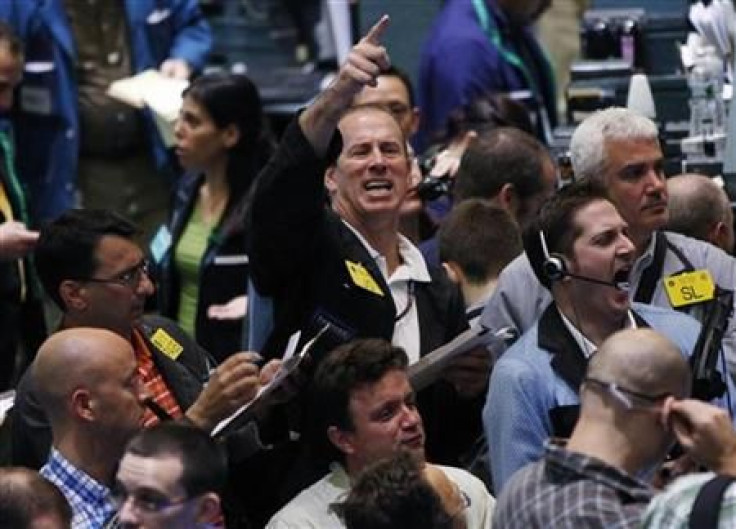U.S. Oil Soars to 12-Week High as Brent Spread Deflates
Oil jumps to 12-week high as Brent spread deflates

U.S. oil prices shot to a 12-week high on Tuesday in a second day of frenetic spread trading, with dealers racing to claw back a record discount versus Europe's Brent as they gave in to evidence of tightening supplies.
While signs of euro zone discord and gloomy U.S. consumer confidence hurt Brent and other risk markets ahead of Wednesday's pivotal European Union leaders meeting, many traders focused more on the dramatic twist in the U.S. market's structure and the collapse in the Brent/WTI spread, which has sunk more than $6 in three days to its narrowest since July.
The market's shift continued to deepen into a structure known as backwardation, where prompt futures are costlier than forward prices. The spread between December 2011 and December 2012 futures surged from minus $1.65 a barrel on Friday to $2.20 on Tuesday, an unprecedented inversion that signals a key shift in mind-set toward a much tighter near-term market.
The heavy selling that drove trading volumes on Monday to their highest since February had subsided by late Tuesday, with some spreads easing off the day's highs even as traders struggled to pinpoint what had set off one of the most violent reversals in key spreads in recent history.
Brent's spread against WTI fell so hard so fast that it looked overdone, so near the close, it recovered a little bit, with no fundamental news behind it, said Mark Anderle, trader at TAC Energy in Dallas, Texas.
The collapse in the Brent/WTI spread and abrupt reversal from contango -- which had prevailed since the 2008 financial crisis -- appeared to stem from a sudden yielding to weeks of growing signs that U.S. Midwest oil supplies were tightening -- something that many analysts had been pointing out for weeks.
The market had gotten secure in the notion that there is and there would be more than ample supplies of crude in and around Cushing, but the fact of the matter is that the supplies of crude deliverable against the NYMEX futures contracts are limited and falling rather than excessive and rising, commodities investor Dennis Gartman said in a daily note.
In London, Brent crude futures for December delivery settled 53 cents lower at $110.92 a barrel. It had fallen earlier after a report that EU finance ministers had canceled a meeting, although a summit of leaders will still take place on Wednesday. It hit a of $112.15 early.
U.S. crude for December delivery settled at $93.17 a barrel, rising $1.90, the highest close since August 2. In early trade, it jumped more than $4 briefly to hit an intraday high of $94.65, the loftiest intraday price since August 2.
EUROPE, US CONFIDENCE WEIGH
U.S. crude came off session highs after a report showed that U.S. consumer confidence dropped in October unexpectedly to its lowest in 2-1/2 years. That stoked worries about U.S. oil demand, analysts said.
Meanwhile, disputes in Europe weighed heavily on other financial markets, with Germany opposing a phrase in a draft conclusion for the EU summit that calls for the European Central Bank to continue buying bonds in the secondary market.
European Union leaders are to meet on Wednesday to consider plans for Greece's debt to be reduced, European banks to be recapitalized and the euro zone's rescue fund to be increased to provide partial insurance for sovereign bonds.
Trading volume in the U.S. market was 41.3 percent above the 30-day average, though the flurry of short-covering and trend-following activity that had driven Monday's volume to the highest since February had subsided slightly. Volume on Brent crude was 0.5 percent above its 30-day average.
The discount on U.S. crude against Brent narrowed to as little as $16.01 a barrel, the tightest since early July. As Brent trimmed losses, its premium to U.S. crude edged up to $17.75 at the close.
The U.S. crude price is responding to a swift reduction in U.S. crude oil stocks in (the) past few weeks, which have plunged by over 10 percent since the end of May. The previous substantial inventory overhang has now been fully depleted, said Carsten Fritsch, a commodity analyst at Commerzbank in Frankfurt.
Stocks at Cushing are 25 percent below the record level of the spring, he added.
A Reuters poll of 35 analysts showed Brent crude averaging $106.80 per barrel next year and $108.60 in 2013 as demand for fuel from China and emerging economies keeps the global oil market tight. U.S. crude is forecast to average $92.00 a barrel in 2012 and $99.50 in 2013.
The market was closely watching U.S. supplies for direction as weekly inventory data from the American Petroleum Institute (API) and the U.S. Energy Information Administration (EIA) will be released on Tuesday and Wednesday. respectively.
Analysts forecast an increase of 1.3 million barrels in U.S. crude inventories, with refined products falling.
(Additional reporting by Robert Gibbons in New York; Ikuko Kurahone in London; Li Pen in Singapore; Editing by Marguerita Choy and Dale Hudson)
© Copyright Thomson Reuters 2024. All rights reserved.











